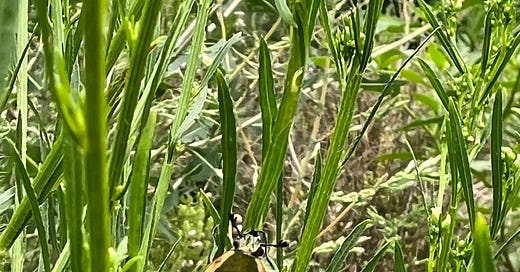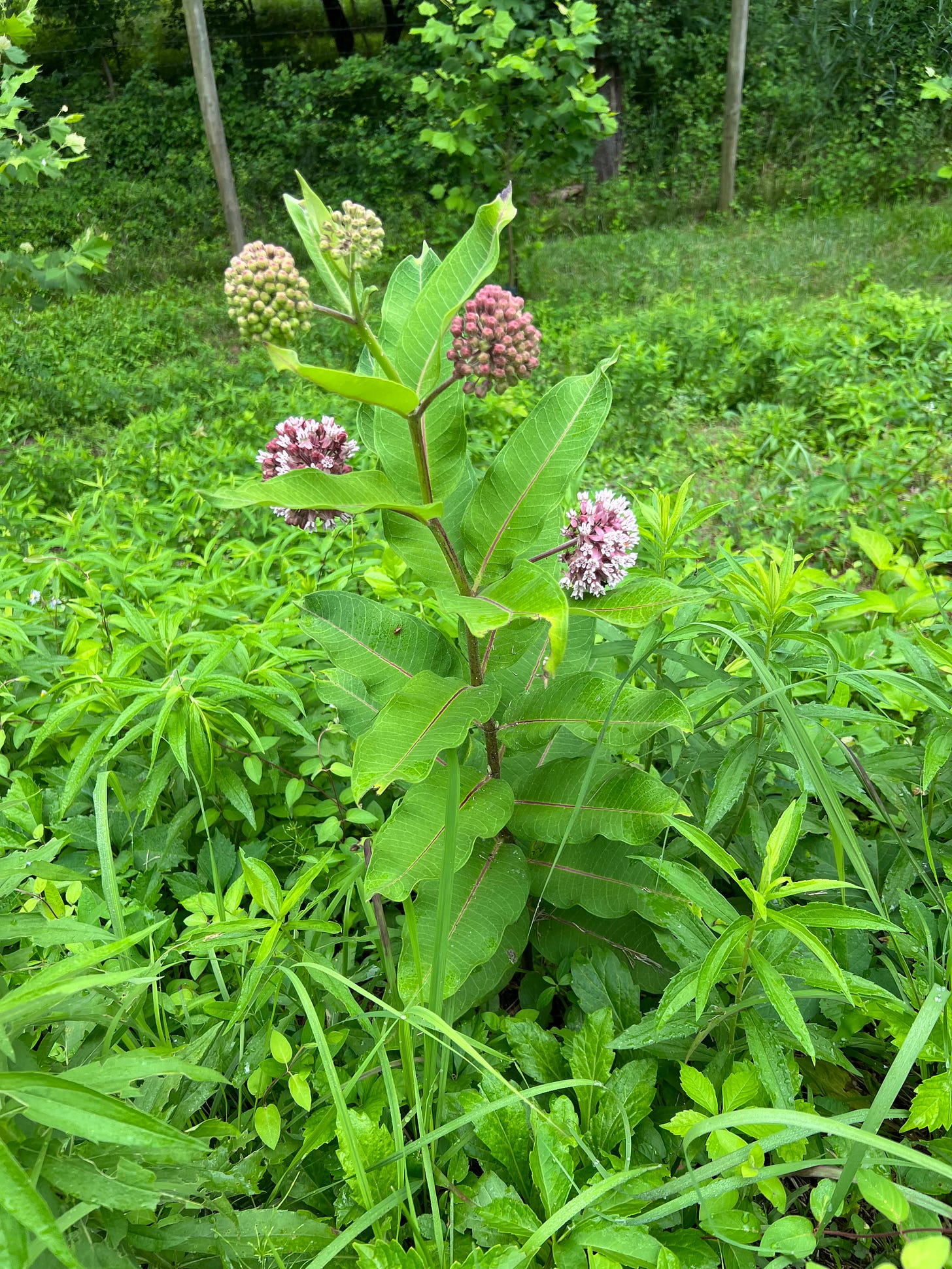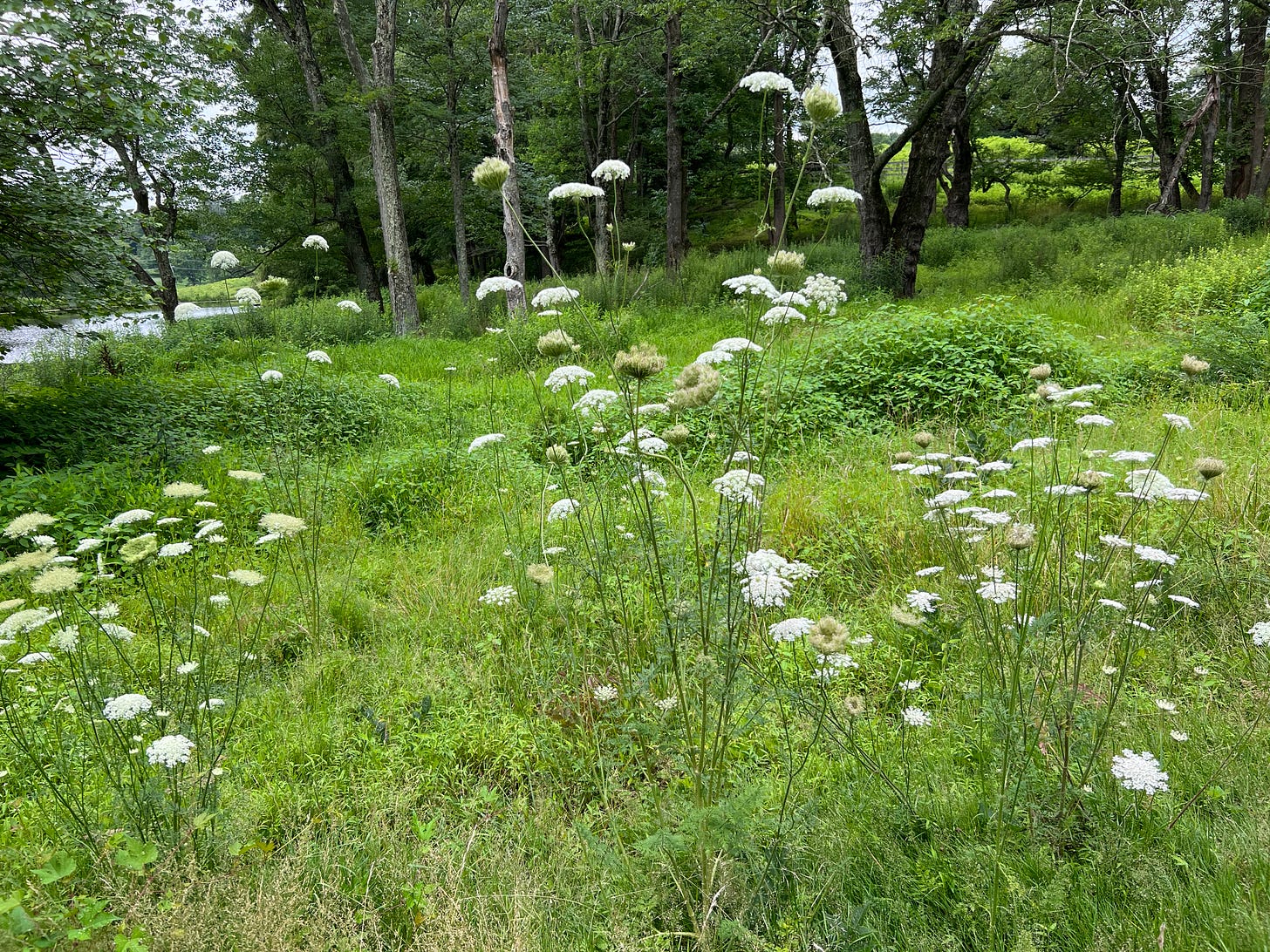Better Living with Minimal Chemistry
Puddock Hill Journal #44: Think twice before using pesticides or herbicides.
An arborist from our local tree service recently came out to evaluate leaf damage to some of the oaks we planted over the past few years. I feared it was a kind of fungus that might necessitate destroying a bunch of young trees, but it turned out to result from the feeding of a moth caterpillar, the oak skeletonizer (Bucculatrix ainsliella).
I may have been able to reason this out myself through closer observation. Last year, the damage appeared on a different tree that remained unharmed this year. Had it been fungus, it might have spread, but I think the evidence would also have recurred on the same tree.
In any case, the oak skeletonizer diagnosis proves good news. The damage, while unsightly, is unlikely to kill the trees, and the moth is native to North America. In other words, it’s part of the local ecology, and native pests and their predators tend to keep one another in balance over time. It’s worth remembering, too, that those caterpillars are likely feeding our birds. No bugs, no birds, to paraphrase the ecologist Douglas Tallamy.
But I fear the first instinct of many of our neighbors would have been to reach for a can of poison.
Most people today are so detached from the sources of their food and water that they imagine the toxins they pour into the environment just evanesce like the Wicked Witch of the West. It behooves the backyard steward to know better (and to attempt to educate those who don’t).
Among the most common pesticides in the United States are neonicotinoids (thiamethoxam, clothianidin and imidacloprid), most of which are deployed as seed coatings on commodity crops such as corn and soy. Despite the fact that evidence of their effectiveness remains in dispute, farmers apply these pesticides every year to crops that cover 150 million acres in the U.S. (They’re now banned in Europe.)
Chemicals in the environment rarely stay put. “In recent years,” according to an article in the Missouri Independent, “the U.S. Geological Survey has found neonics in rivers across the United States, tributaries to the Great Lakes, and well water and groundwater in Iowa.” In fact, research “shows that treated seeds lose up to 95% of the pesticide to the environment.”
If you don’t live in Iowa, maybe you don’t consider this your problem. Then again: “A 2022 study from researchers at 16 institutions across the United States found [these] chemicals in the urine of 95% of pregnant women in California, Georgia, Illinois, New Hampshire, and New York.” If they didn’t find it in your state’s urine, that’s probably because they didn’t look.
There are farms all over the place, of course—44 percent of all land in the U.S. goes to agriculture. Even if you don’t live near any of that land, your neighbors might be applying neonics to their properties as I write. A Massachusetts list of brand-name “Neonicotinoid Pesticides that Meet Current State Restricted Use Criteria” runs to 28 pages. While Massachusetts may restrict them, most states have far lighter regulation.
What’s the harm? Neonicotonioids are systemic pesticides that kill or harm many insects beyond the target ones that may feed on a treated plant. (This goes for plants treated intentionally or wild plants inadvertently exposed to the chemical.) They have been implicated in reducing native bee populations through direct killing and by adversely changing bees’ foraging habits.
In total, Neonics and other pesticides are believed to threaten more then 200 endangered species in America, but I think only focusing on endangered species understates the damage. Given our ongoing poisoning of the environment, many of today’s secure species could be tomorrow’s endangered ones.
I have focused here on neonics, but other pesticides and herbicides (I’m looking at you, Roundup) have been shown to have adverse effects on wild animals and human health. Many more have not been thoroughly studied, so who knows.
For these reasons we use chemicals only as a last resort at Puddock Hill. But I’d be lying if I said we can avoid them completely.
So many of our decisions involve necessary compromise. Although the arborist assuaged my concerns about the oak skeletonizer damage, as we walked he found lace bugs (Tingidae spp.) on two mature white oaks and evidence of ambrosia beetle (Curculionidae spp.) on an old red oak that recently lost a giant limb. Furthermore, an ongoing infestation of woolly adelgid (Adelges tsugae) that I’ve been monitoring for years on five ancient hemlocks at the far end of the big pond has exploded. While only the latter are foreign invaders to my knowledge (the others may be, but I’m not sure), I acceded to his suggestion to treat all three infestations.
As I sat down to write this piece, the treatments had already been completed using a systemic product called Transtect, which I now see — wait for it — is a neonicotinoid!
What do I do next time the arborist comes to offer his recommendations? Turn him away and let the oaks die?
The arborist, who has been in the field for forty years, says that, due to the warm winter, this has been the worst summer he’s ever seen for insect infestation. And the future? Our winters only grow warmer as a result of anthropogenic climate change.
I am reminded (as I so often am) of Alan Watts’ definition of karma.
Man is involved in karma when he interferes with the world in such a way that he is compelled to go on interfering, when the solution of a problem creates still more problems to be solved, when the control of one thing creates the need to control several others. Karma is thus the fate of everyone who “tries to be God.” He lays a trap for the world in which he himself gets caught.
When it comes to managing our gardens and our land, we are all caught in that trap of our own collective making.
It may be impossible to take the path of a purist in this changed world, and perhaps none of us with any ambition can manage to do zero harm. Still, we owe it to ourselves and nature to use pesticides only as a last resort.
A native green June beetle (Cotinis nitida) clings to a leaf in the wet meadow:
Common milkweed (Asclepias syriaca) flowers near the big pond:
Oops. I identified this plant as native Jimsonweed in the emailed newsletter, but I’m pretty sure I blew the call. I may get clarity when it blooms, which should be soon:
Endemic Queen Anne’s lace (Daucus carota) shows off on the dry slope near the wet woods and big pond:
A native black swallowtail (Papilio polyxenes) feeds off native sweet pepperbush (Clethra alnifolia) near the house:







